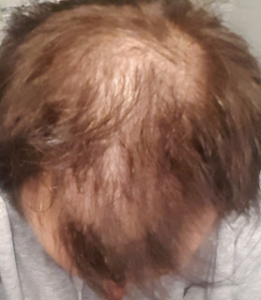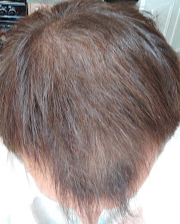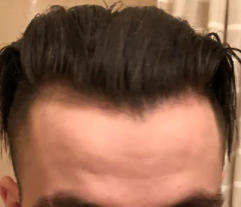Dr. Rassma has been working with UCI for 4 years in the development of this breakthrough drug: https://www.nbclosangeles.com/news/local/one-molecule-may-be-the-key-to-whether-or-not-you-lose-your-hair-uci-study-finds/2949359/
You can get a hair transplant without medications; however, if you are under 30 and/or had recent hair loss, then shock loss is a high risk without taking oral finasteride prior to the surgery.
Early hair loss is the problem. Anyone whose hair loss is recent, will usually have miniaturization that is extensive. It is these early miniaturized hairs that fall out. Most men above 30-35 have already lost their miniaturized hairs. Finasteride holds on to these hairs in the face of a hair transplant.
I believe for long term balding areas in men over 40 when the skin infrastructure has been gone for more than 10 years, microneedling will have a lesser chance of producing hair growth and I would not recommend its use in that situation.
I am looking for a company that can assist to develop this concept. A rough idea would be to connect 4 strands of hair together with some sort of silicone, using a device would then pin a hole between the 4 hairs and your hair would then slide through holding it and then that would be pushed down to the base of your hair/scalp.
It would need to be minute but surely not impossible. I do think there that is huge place for “hair options” or simply a way to “melt” a strand of hair to your existing hair so make it longer the thicker.
Any help to get this going would be appreciated.
This produces traction alopecia pulling out the hair that you bond to. Single hairs can’t support 3 additional hairs bonded to it. The idea is being done commercially and those that do it, charge a lot for it. The people who get it done on themselves, become balder the more times they do it. Not a good deal when a hair transplant solves the problem.
I generally tell my patients that if you have an advanced balding pattern or expect to have a hair transplant, then the strip surgery is a better surgery for harvesting. Large amounts of FUE grafts can produce a see-through donor area if too many grafts are harvested
This young man is in trouble as he wrote to me to tell me that he now has a Class 7 pattern of balding and that his original hair transplant failed. He had advanced balding when he was 19, which means that he will likely end up with a Class 7 pattern of balding. Transplanting someone like this requires a detailed Personalized Master Plan with regard to his donor supply and its overall integrity. If I knew that he was going to have a Class 7 pattern of balding, the last thing I would do is to rush a hair transplant. Did he know his eventual outcome when he started this process at 19. I doubt it. Was he counseled? Did he have a Personalized Master Plan created with his doctor to plan for a Class 7 eventuality. What is the caliber of his donor hair, its original donor density and his hair mass index. What if he doesn’t have enough hair to leave him looking normal? The surgeon here is a criminal, taking money from this young man for his own personal gain. I also would like to know why this transplant failed? Was it because the doctor didn’t use permanent hair or was the doctor and his team just not competent? I suspect both of these!
I wrote an extensive article on the combination using FUE and SMP together to increase the value of the hair in a hair transplant here: https://newhair.com/wp-content/uploads/2018/11/Combining_Follicular_Unit_Extraction_and_Scalp.98621.pdf
The number of grafts is determined by the size of the balding area (moderate) plus the thickness of each hair (fine, medium or coarse). IF it were fine, it would be a stretch to recommend 2500 grafts but for fine hair that would be ok, but for medium and coarse hair, adjustments downward is appropriate. The key is to get the best result possible without wasting the donor supply in the case you will need it in the future. Here is a patient who followed my instructions in defining the quality and quantity of his donor supply: https://baldingblog.com/creating-a-personalized-master-plan-for-present-and-future-balding-photos/
I’ve been on propecia 0.25mg eod for three months now and I now experience ache in my right testicle. I have varicocele or hydrocele (dont know which one is is tbh :/ ) for couple of years but further examinations said that it was nothing to worry about. Does propecia increases the risk of testicular cancer?
In the early 2000, the new England Journal of Medicine posted an article showing that finasteride reduced prostate cancer risk by 25%. I have also looked up to see if there is a relationship between finasteride and testicular cancer and I can find no evidence that there is such an association at this time. At the time of the original publication another article appeared that suggested that those who developed prostate cancer on finasteride had a more aggressive form of that cancer; however, a review at the Mayo clinic disproved that and found that more aggressive prostate cancers were not produced for men on finasteride. I found that if there is a relationship between finasteride and testicular cancer, I can not find any such evidence
If I had side effects on dutasteride, would it take longer for them to go away after quitting use due to dutasteride’s long half-life?
Yes, most probably! We know the half life is in weeks (half life in the blood) but the half life in the body’s tissues are much longer (I don’t know those numbers) but it is suggested that it may take several months for your body’s tissues to get rid of dutasteride.
Thinking of starting to take Fin but I have to wear a hat for work. Will that affect the progress?
I had does not cause hair loss unless it is tight and rubbing
I am 20 years old about to turn 21 and I’ve noticed these past few years how my hairline is starting to “recede”, however, contrary to what many people here post, I don’t notice excessive hair shedding (when I shower the amount of hair looks normal, I don’t notice hairs in my pillow etc.)
Could this be a sign of just a “Maturing” hairline? Or could it be receding just that hair shed is not very noticeable in early stages?
Usually, balding starts with either recession of the frontal hairline, thinning of the crown or excess hair shedding. Men in their late teens (some up to the age of 29) will evolve, losing their rounded juvenile hairline into a V-Shaped mature hairline without shedding a single hair.






